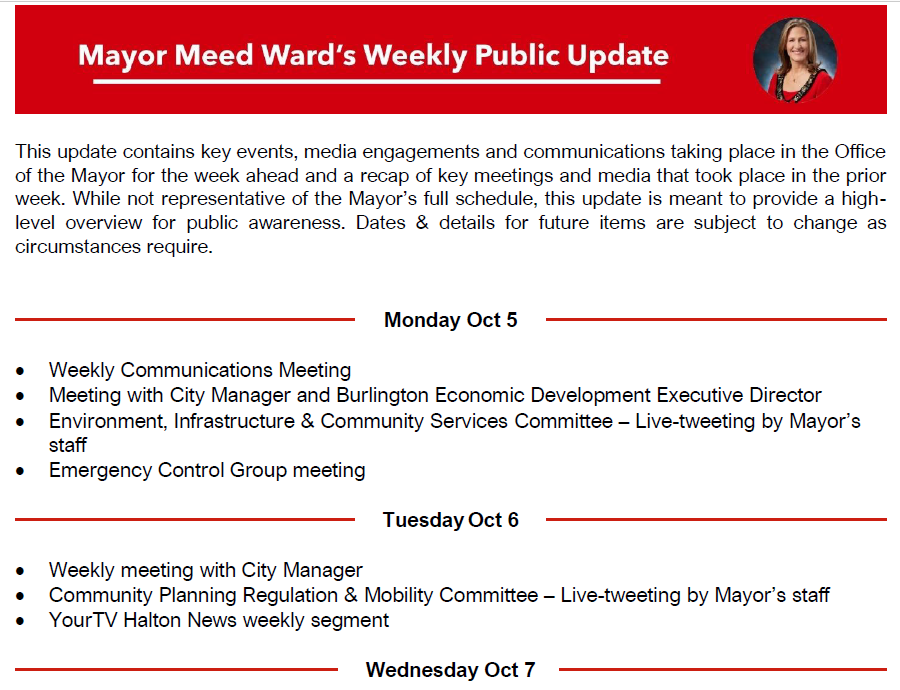
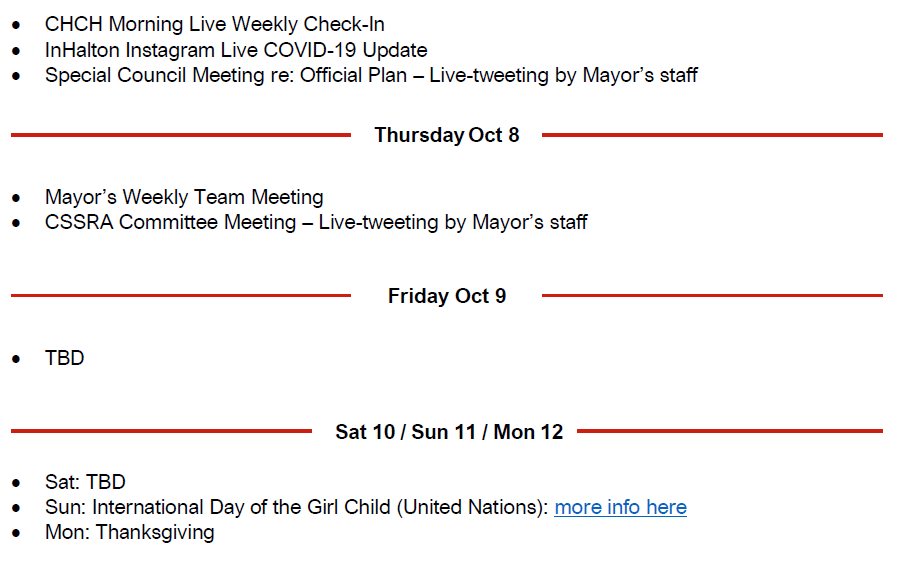

|
|
||||||||
|
October 5th, 2020 BURLINGTON, ON
The first of the Public presentations of a new development under the new rules took place last week. The new rules require a developer to present their plans to the public and get feedback before taking their project to the Planning Department. The rules are a little on the complex side and were the subject of some debate, which we cover in a separate article. The presentation was done by the ADI Development Group and was focused on the second stage of their Station West development. The first stage is well underway – the developers said that there are already people moving in. Something about that first phase – it is huge. Unless you drive north on Waterdown Road from Plains Road you might not see it. But drive north on Cooke or along Masonry Court and there it is – right in front of you. Cooke is extended right into the site of what amounts to six lengths of row housing. 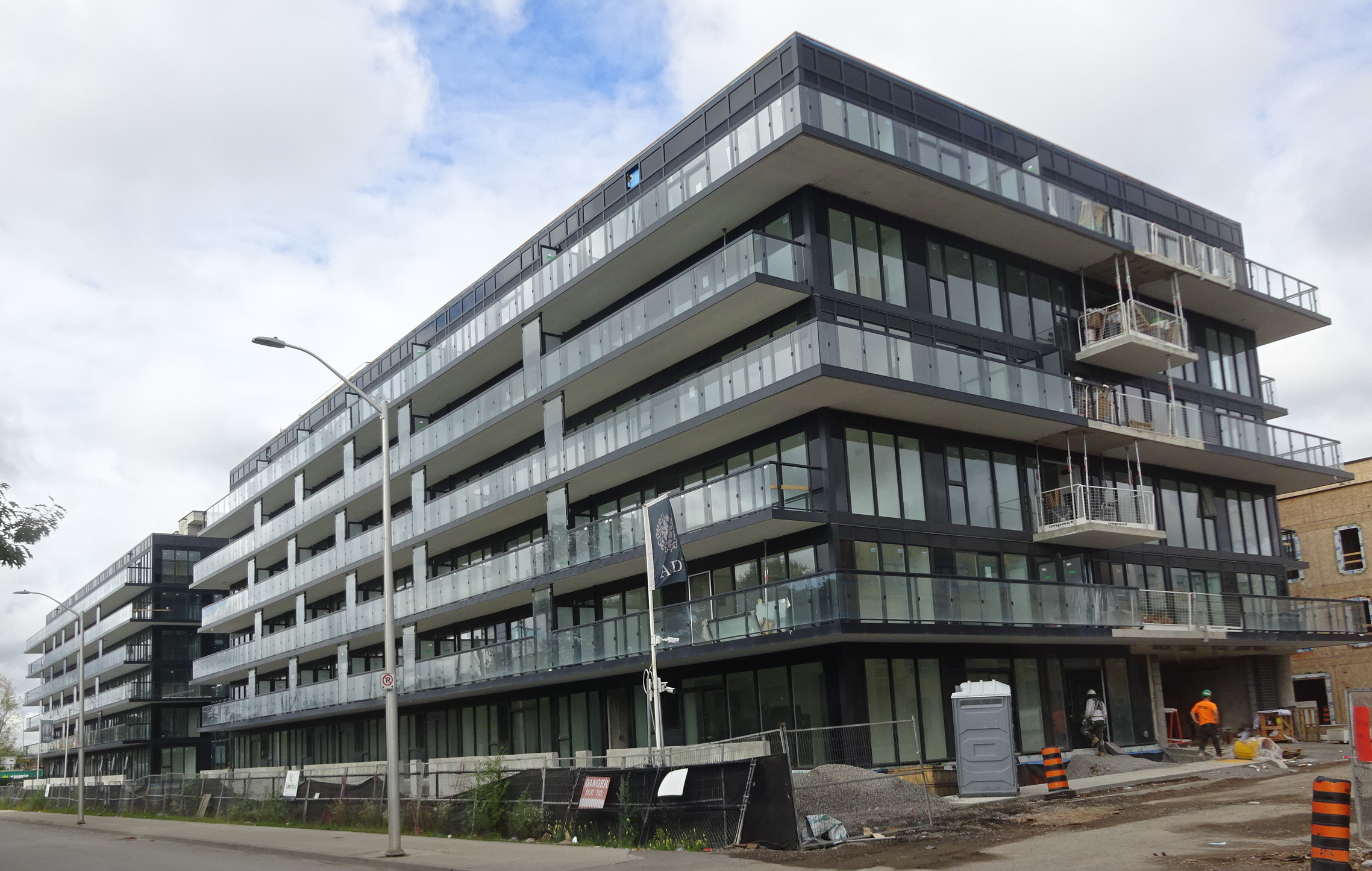 The two structures are joined by a lobby area where the elevators are located. We weren’t able to determine just how many elevators there are. 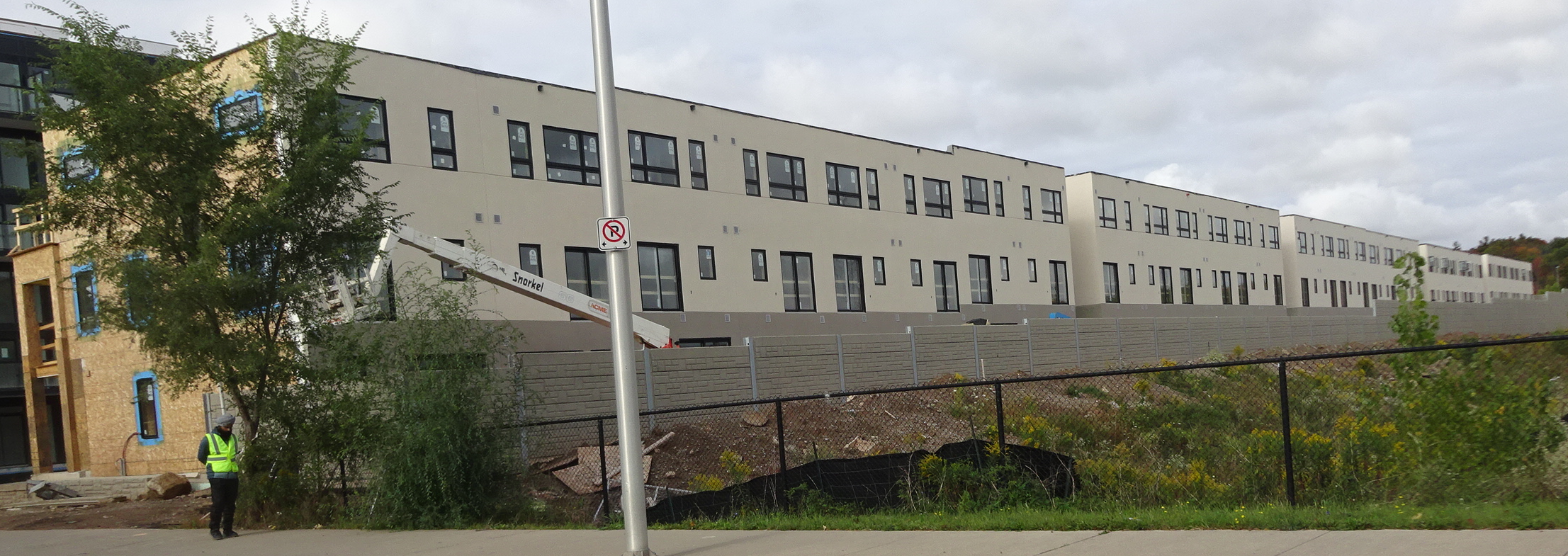 This is the eastern boundary with the Aldershot GO station a short walk away. This is what intensification looks like. 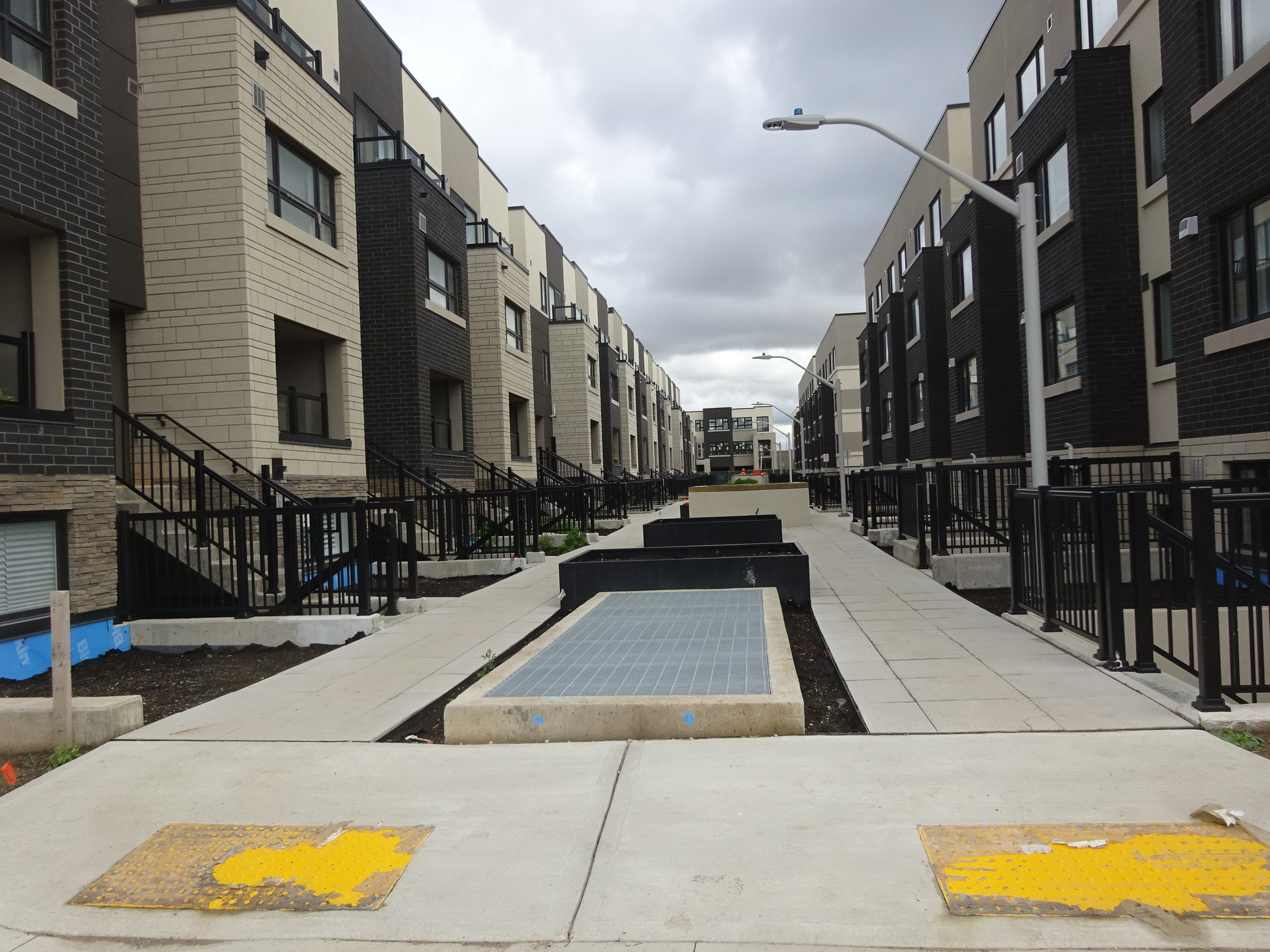 Reasonably attractive, underground parking, basement units with a separate entrance – but it is still row housing with precious little in the way of grass. The meeting was to talk about phase two which is projected to be four towers (but it could be three) with heights of between 18 and 39 storeys. 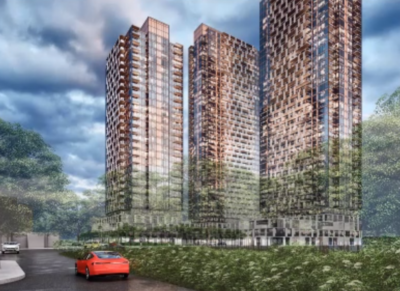 Architectural rendering of the the tower option for phase two of Station West. Where is there any retail? Those questions didn’t get answered during the hour and a quarter virtual presentation. More on that in a separate article. The presentation itself was not all that bad. There were three people who could be described as public taking part. That was probably because there was very little in the way of public notice. The Gazette did a short piece two days before – not much time for people to read up on the development and prepare their questions. The meeting was to get public input on phase two – the first phase is a done deal. The developer was offering two versions: one with three towers, a second with four towers. 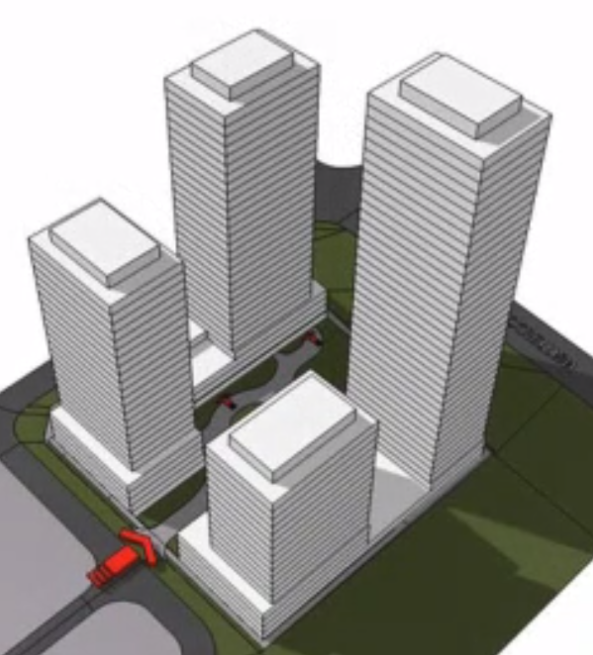 Four towers with some green space in the middle. Height will run from 18 to 39 storeys. 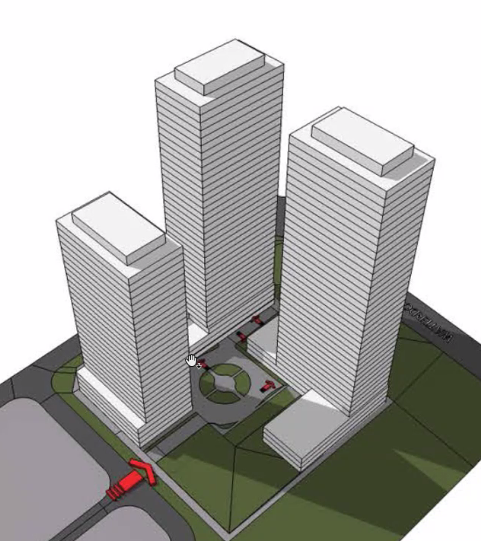 Three towers with small park space in one corner. One tower at 29 storeys two at 39 storeys. The three tower option was made up of one 29 storey tower and two 39 storey towers. The four tower option had buildings ranging from 39 storeys to 18 storeys. There will be additional opportunities for public input. The truth is that there isn’t a community in place yet – there is no one to speak for the development and what it offers for those who see it as a place to live. It is reasonably priced – said to be in the $700,000 range. There are no homes in the immediate area that will be severely impacted by the high towers. The development started when Rick Craven was Councillor for ward 1. The land was reported to have been purchased from the Paletta interests for $14 million. The ADI group has in the past built quality housing with some very innovative design. Their Nautique in the downtown core is a smart looking 26 storey structure that has broken ground. Getting to the point where they were able to start building meant breaking a lot of the rules; put another way – they were able to convince the then OMB that the little bus station on John Street was an MTSA – a transit area and that justified the height they were asking for. The ADI’s are tough, very in your face developers. They don’t take prisoners – but they are in the process of creating a community that lacks severely in the way of amenities. 
October 5th, 2020 BURLINGTON, ON
The flow of information from the Halton District School Board and the parents with children in school could be better. What the parents are not getting is the bigger picture – information that sets out what the Board of Education is up against and the challenges they have to overcome. It is October and we are hearing of what is called “June burnout” on the part of teachers. They are being asked to do a job that isn’t the cake walk that a lot of parents talk about – they now have to perform under very different circumstances. A thicker flow of information would be useful. Where the parents in Halton are being informed is through the Chair of the Board of trustees. Andrea Grebenc, serving her second term as a trustee, now has a much firmer grip on the job and she is speaking out.  Chair Grebenc listening to Director of Education Stuart Miller Grebenc has an excellent working relationship with her Director of Education Stuart Miller. There are issues that Miller can’t say all that much about – but the Chair can. Over the weekend Chair Grebenc said the funding is not what the province is saying publicly. Her Board decided to use $6.1 million out of the reserve funds to cover pandemic related expenses, “that is $6.1 million that was earmarked for other expenses. “As an example, if we say OK allocate these reserve funds to hire more teaching staff, then we won’t be able to afford to give this school, this school, and that school the air conditioning they have been begging for for years. That’s the trade-off we are looking at. It’s not just money sitting around doing nothing” Grebenc said. “It’s robbing Peter to pay Paul” she added. In Halton about 20% of the students are being taught virtually. There is an opportunity for them to move from being virtual to in-class students. The Board at this point has no idea how many will make the switch. 
October 5th, 2020 BURLINGTON,. ON Throughout the month of September 2020, several businesses were broken into involving at least two suspects targeting A.T.M.s where an undisclosed sum of money was stolen. As a result of the investigation, one suspect was identified by investigators. On October 3rd, 2020, a Criminal Code Search Warrant was executed at a residence in the City of Burlington and the accused was arrested. The investigation led to charges against the following individual; John BAILEY (48 years old from Burlington) • Break and Enter – Commit; contrary to the Criminal Code of Canada – (7 counts) The accused was later released on a Form 10 Undertaking. Investigators are still seeking to identify the second involved party. Anyone with information in regards to this investigation is asked to contact Detective Melissa Parsons of the 3 District Criminal Investigations Bureau at 905-825-4747 ext. 2307
Please be reminded that all persons charged are presumed innocent until proven guilty in a court of law. 
October 4th, 2020
Last week Council endorsed the recommendations from the Planning department on the Scoped Review of the Downtown Core portion of the adopted but not approved Official Plan.
The endorsement goes to Council this week and, if approved, will be come part of the Official Plan that is currently in the process of being revised. It will be sent to the Regional government where it has to be approved.
Citizens created an organization they called We Love Burlington, (WLB). That group released the following statement related to an article the Gazette wrote on the decision of Council to endorse what the planners had brought forward.
The WLB statement should be part of the public record.
 Last December and January, WLB delegated before City Council opposing the direction proposed in the returned Official Plan for downtown development and the public waterfront. We were joined in our opposition by our colleague, Gary Scobie, long time civic activist and critic. Today we post a submission by two members of WLB and Gary on the virtually unchanged but ‘final’ direction for downtown and the waterfront. We continue to advocate for local voice and respectfully request that it be heard. If you agree, contact your Councillor and make your voice count. We strongly suggest looking carefully at the morass of documents and not simply the consultant’s Guidelines nor the summaries provided by the City or council members.
September 21, 2020
The following is the joint submission of Lynn Crosby and Blair Smith, two founding members of WeLoveBurlington, and Gary Scobie, long-time civic activist and advocate. We share a common passion for the City of Burlington and a common purpose in protecting its downtown and waterfront from inappropriate development and excessive intensification. We also have a compelling interest in preserving the integrity of local government – that level of governance closest to the citizen and most sensitive to local needs and voice. Indeed, WLB actually was created by the need to counter the provincial direction for amalgamation at the regional government level. The campaign, waged in concert by a number of ad hoc organizations, was ultimately successful and the threat of amalgamation in Halton removed.
Ironically, the government that WLB fought to preserve because of its perceived sympathy to the people’s will, then turned a virtual deaf ear to many of those citizens when it developed its revised plans for Burlington’s downtown. It would appear that proximity to the people is no guarantee of either the ability to hear their voice or follow their wishes.
On December 5th, 2019 and January 12th, 2020, we delegated before Council. On those occasions we questioned the timing and basic process of the course that brought forward the 243-page Integrated Control By-Law Land Use report and the highly interdependent 319-page Preliminary Preferred Concept Report. We challenged the timing, the conclusions and the basic sequencing of events. At that time, we urged Council to address the relocation of the Urban Growth Centre (UGC) and the mis-designation of the John Street bus station and the downtown as a Major Transit Station Area (MTSA). We argued that these actions must be a priority before any acceptable redesign of the downtown was possible. We asked for ‘no more tall buildings’. And we were not heard. Indeed, with our final delegations there was not one question posed. We raised inconvenient truths and there was no will to exchange ideas, no appetite to debate. We were politely but conclusively dismissed. We determined at that time that further delegation was pointless and the course for downtown irrevocably charted.
Today, however, we are making another statement in response to the latest documents, the Placemaking and Urban Design Guidelines and the Downtown Burlington Fiscal Impact Analysis and the latest, and apparently final, version of Report PL-16-20, Taking a Closer Look at the Downtown Recommended Modifications to the OP. We do this to bring orderly closure to our advocacy and, once again, echo the voice of Burlington citizens who deserve to be but have not been heard. Sadly, the situation remains almost exactly the same as it was nine months ago – all this time spent tinkering with the documents, but not substantially changing the position or the “vision.”
On page 8 of the Guidelines, for example, the two designations that enable both the Province and the development community to force high intensity massing of people and/or jobs in Burlington’s downtown remain unchanged and in force. We refer, of course, to the Urban Growth Centre (UGC) and the Major Transit Station Area (MTSA). COB recently announced that Council voted unanimously on August 24, 2020 to request removal of these designations, yet they remain the key component of the downtown OP, the Guidelines, all Schedules and the Fiscal Impact Analysis. Coupled with this is the fact that LPAT, the ‘new’ dispute forum, is a high-rise developer’s dream tribunal where height and massing in designated growth areas are not just supported but are actively encouraged.
The Urban Growth Centre (UGC) designation was first applied to our Downtown through the Places to Grow provincial legislation in 2005 and ratified by Burlington Council in fall 2006, just weeks before the City Election. It demanded a minimum 200 people/jobs per hectare over the area bounded by the Growth Centre and remains in place today.
The Major Transit Station Area designation arrived much later in the second decade of this century through the provincial agency, Metrolinx, based on the unsubstantiated claim that our Downtown Bus Terminal qualified as a Mobility Hub. The MTSA covers roughly the same area as the UGC and requires the same intensification minimums. Both designations support high intensity massing of people/jobs (and buildings) in the Downtown area and reinforce each other as provincial intensification tools. Moreover, both designations share three critical aspects detrimental to the popular “vision” of what constitutes “good planning” for Burlington’s downtown:
The intensification applies over an area, not a building. There is no maximum stated. Only a minimum is demanded, and municipalities are “encouraged” to go above the minimum. There is no mention in the legislation of maximum building height – the sky is quite literally the limit. So, the two most damaging factors remain unchanged and will be ‘in force’ and operative for the foreseeable future – at minimum, until the Regional Official Plan is revised and approved. This factor alone undermines the comforting assurances and lofty principles of the Guidelines. Indeed, the latter are almost a misdirection, intended to appease a skeptical and fatigued citizenry; false guarantees that intensification can be controlled and made amenable to the public will. But, as Guidelines, they exist simply to articulate what “should be” not what “must be” and they can be contravened by any number of higher policies and direction statements. For example, the “Core Commitment: Downtown Vision and Action Plan” (as amended) goes beyond and takes precedence over the “Placemaking and Urban Design Guidelines”.
In essence, the Guidelines are unenforceable, part of an array of reports and documentation that requires a very informed and patient reader to do all the necessary cross-referencing to determine the complete context. As with the past process of last December and January, the documents are too numerous, too dense, too intricate and too complex. They are not intended to easily inform.
Truly, the devil can be in the details. There are instances in which the Guidelines don’t match or conform to the main OP report. One of the best examples is Village Square. The Guidelines talk about 4 storeys “abutting Martha Street” but Village Square, as popularly known, does not extend to Martha Street.
The Guidelines state:
“1. The maximum height of developments abutting Martha Street shall be 4 storeys and/or shall provide a built form transition to Martha Street and north of Pine Street to maintain the existing low-rise character.”
2. Retail frontages should be designed to complement and reinforce the unique human scaled and historic character of the Village Square Precinct.
3. Retail provided at-grade along Pine Street will act as a transaction to the Village Square development and emphasize an intimate relationship with the public realm by providing a minimum setback of 4 metres from the curb.
4. Development should maintain and enhance views of the Village Square.”
The language is intended to give the impression that the low-rise nature of the area is being protected and preserved. However, when the map (notably, only included in the revised schedules and omitted from the Guidelines) is referenced, it is clear that the north portion of Village Square allows 11 storeys. Moreover, both the Report and the Guidelines are silent on the treatment of the Square’s interior. At best this is misleading; at worst, a deliberate omission. And this is characteristic of the Guidelines as a whole. They contain a treasure trove of vague, ambiguous, qualitative language that provides a sense of affirmation but does not allow for measurement or objective validation.
The Guidelines perpetuate a number of known problems and deficiencies already cited with the planning process and the downtown modifications made to the Official Plan. Most glaring, perhaps, is the fact that the Old Lakeshore Road precinct continues to be ignored. Why is this most critical of precincts, the gateway to the downtown, continually out of scope?
Why are the serious issues, constraints and challenges posed not openly addressed? Why reference it as one of the 10 precincts and note that the downtown is “on a beautiful waterfront setting”, then completely ignore what is required to protect the waterfront, enhance its accessibility to the public and maintain the existing views? Indeed, Burlington has had a very uneven record over the last 20 years in terms of preserving and protecting the natural asset of the waterfront. It sold valuable waterfront property to private owners, failed to extend the waterfront trail and allowed development interests to prevail over those of public access. These Guidelines and this Official Plan do little to reverse the mistakes of the past. World class cities provide strict and enforceable measures to ensure that their waterfronts are valued as irreplaceable jewels and true public assets. Burlington, by contrast, posits a “feel good” set of principles (pp 44/45) factored around the discretionary preservation of “views” and “access”.
The same principles with the same poor expectation of effective implementation are used to preserve sight lines to landmark buildings such as City Hall, Knox Presbyterian Church and Village Square. One can reasonably argue that the view of City Hall will be obstructed by the Twin Towers approved for the northeast and southeast corners of Brant and James. Knox is located in the Downtown East Precinct that allows tall buildings and is vulnerable to demolition. Village Square presents a series of already identified issues. In fact, we take serious issue with the whole Downtown East Precinct in which the “precedent” of existing tall buildings is used to justify an ongoing ‘tall building’ development pattern. Why is the “precedent” not anchored in the many one or two storey houses in the area? How does the allowance for 17 storeys on Elizabeth Street and 17 at the Lions Club Park conform to the existing adjacent neighbourhoods? How does it conform to that which the people have been asking and how is it feasible that that small area around tiny Martha Street and Lakeshore/James could possibly accommodate this many tall buildings and additional congestion? Where is the requirement that Carriage Gate finally, after more than a decade, build their promised parking garage and medical centre at the site of their 17-storey condo building atop a three storey “podium” (the much-touted retail portion on ground level still completely vacant) located in the East Precinct? Why is the consultant/staff recommending 22 storeys at the Carriage Gate property at Pearl and Lakeshore, beside the uniformly unwanted ADI property next door?
There is almost a complete lack of green space and amenities. The map in Schedule 3, Appendix D shows three green circles denoting “public parks” (viz. Ghent/Brant, No Frills parking lot and Martha near New Street). They are small, located in insignificant areas and appear as afterthoughts – not integral components of the plan. The City claims to want to create complete communities with all of the amenities, but this worthy goal appears to have been abandoned in the downtown. Indeed, there is no section in the Guidelines dealing with green spaces and parks. Instead of needed amenities, community hubs and actual parkland, we are presented with the concept of POPS (Privately Owned Publicly Accessible Spaces) as leisure and recreational areas for the thousands of people who will populate the new buildings. The POPS were featured in the Fall 2019/Winter 2020 presentations of the preferred concepts for downtown. They were not critically acclaimed then and deserve no better treatment now. In fact, little has changed with either the concepts or the consultant’s treatment of the design for downtown. So, for example, where is the recognition that the pandemic has dramatically changed our reality? In the Fiscal Impact Analysis:
“Table 3-1 summarizes the residential growth projections for Downtown Burlington to 2031. It is anticipated that the within Downtown Burlington, the City’s population will grow by 2,787 population over the 2020-2031 forecast period. The population growth will be facilitated by the development of 1,720 additional high-density residential dwelling units. Consistent with the assumptions of the 2016 FIS, it is assumed that 75% of high-density residential development will be in the form of condominium development, with the remaining 25% comprising apartment developments.”
Remarkably, there is no updated view of the changes that COVID has made to our lives and the nature of our future living. Today, and for the foreseeable future, there is far less desire for condominium living and cloistered spaces. People want to distance and separate, want more open spaces and houses with traditional features and backyards. Accordingly, there should be fewer allowances for tall buildings and much better-defined planning for open spaces. Why is the consultant’s vision unchanged?
This speaks to our final major issue – the implicit cynicism of the consultation process and the lack of meaningful public engagement. Much has been made by the City and Council in ward newsletters and social media posts of the extensive outreach that has been undertaken. Citizens have been thanked for their time and effort reviewing an endless array of documents, helping to make the Official Plan and its policies a better, more inclusive work. However, nothing has materially changed. The preferred concepts, the vision and principles, the Official Plan itself with its myriad ancillary reports and the strategic documents ‘ad infinitum’ have not been varied or amended. The direction has not been moderated by either public comment and feedback or influenced by a differing public perception. The development scenario was essentially set during last Summer and Fall, when SGL Consulting was engaged under a directed tender to validate staff-defined outcomes. The necessary substantiating reports and studies were then concluded with predictable findings and the path forward unaltered from that framed and established at the very beginning.
Neither Council nor Planning staff should believe that a lack of new comments opposing much of these final documents means that the public now finds them acceptable. In the midst of a pandemic and at the end of a very long, quite protracted and overly tiresome process with too many documents, too many cross-references and too many versions, people are fatigued with the need for repetition; for saying repeatedly what they want and never being heard. We know that the council members are there to speak up on our behalf, convey our long-standing and unchanged positions, and to direct staff as they see fit. This is what the public expects and is counting on.
In summary, we’ve been here before – several times actually and nothing substantive has changed. It’s not that we expect that Council is under any obligation to passively comply simply because we attended and delegated. However, we did expect to be respected and to be heard. We represent a popular voice to which you have turned a deaf ear; worse, to which you have claimed an avid attention, then done nothing. We respectfully request that you provide for substantive amendments to the Official Plan, addressing the deficiencies noted in this submission and reflecting what the people of Burlington want for their downtown.
We understand that Council has worked with staff on modifications to produce a revised Official Plan for endorsement but we believe that it is seriously flawed. It leaves the waterfront vulnerable to development and permits a downtown in which tall buildings will dominate, with no real green space or public amenities. As we have said from the beginning, there is only one waterfront and one downtown – once gone there will be no bringing anything back and we urge the current Council, elected with such high popular expectation two years ago, to do everything needed to clearly ensure their permanent protection. Your legacy depends on it.

October 3rd, 2020 BURLINGTON, ON
Haven’t we seen this movie before? The eagerness to open up the economy before the virus was properly contained has returned us to where we were back half a year ago. In fact worse. We have already exceeded the record of infections we saw last spring. Does that mean the long months of lock down were all in vain? Who is running this ship anyway ? Dare I say… this was, of course, entirely predictable. And now we’re expected to top 1000 cases in a of couple weeks. But we really have no idea, since the virus is exponential and there are lags between exposure and symptoms… and well… who knows? 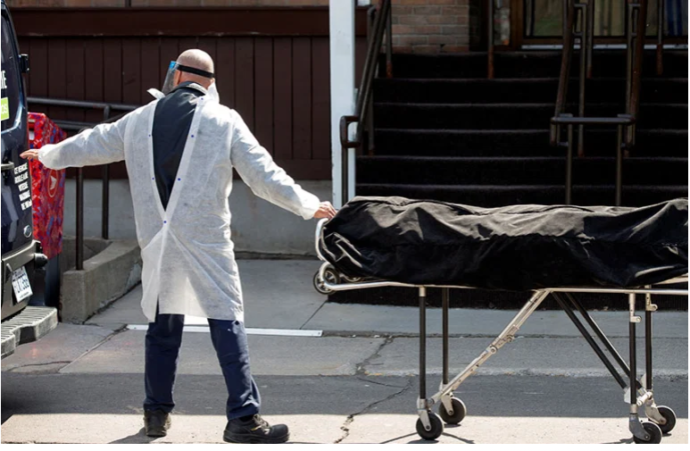 Infections have reached 1000 a day in Quebec. Deaths have also increased. Quebec has already beat us to the 1000 cases a day, by the way. Yet it was barely three months ago that Premier Legault was so convinced he’d beat the virus to the ground that he opened up provincial restaurants and bars and invited customers in – Bon Appétit. And now he has had to shut them all down. Earlier this week on the very day that Ontario hit its highest level of infections ever, 700 cases, casinos in the province were allowed to reopen. And still the Premier thinks he is smarter than the virus – that he can outmaneuver it, surgically control it, micro-mange and fine tune how we live our lives to constrain it – rather than doing what his neighbouring province has had to do. We are all waiting for a vaccine to save us – something we expect to have by early next year. So one has to ask – why not sit tight and wait? Oh sure we need money to live by – but the feds have the printing presses primed – and most of us are doing better than ever if we consider the amazing growth we’ve seen in personal savings. COVID is the viral disease making all this fuss, but this is also an economic and social crisis of historical importance. Provincial gross domestic product (GDP) suffered its greatest loss ever. This is entirely attributable to measures we’ve taken to flatten the curve (of infections). And were it not for the federal government doling out cash we’d be in big trouble. Ontario lost over a million jobs during the June to August period. 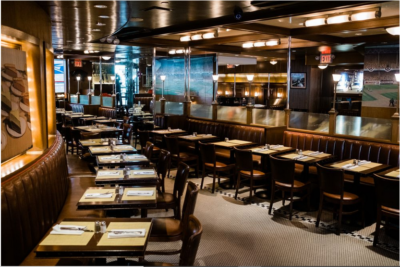 Restaurants are taking the biggest hit – and there doesn’t appear to b a solution for them in the near term. While just about every sector had been affected by the epidemic, entertainment, travel and hospitality were the hardest hit. These are the business activities where viral spread is hardest to control. Hospitality and tourism make up about 4% of provincial GDP generating over $22 billion in sales in a normal year. Together with restaurants there are over 11,000 establishments across the province.  If the virus gets even worse, the Premier knows he’ll have no choice but to lock them down again. And that is the dilemma facing the Premier. If the virus gets even worse, he knows he’ll have no choice but to lock them down again – when hospitals get overloaded and more seniors start dying he won’t be able to pretend that his surgical blade can do the impossible. He’s already getting flack from health experts demanding more lockdown and that he fire his chief medical officer. It’s not easy being a man without a plan. And it’s clear the Premier is making it up as he goes along. Every new daily briefing brings some new direction, which may conflict with the one from the previous day. And while he can predict we’ll have a thousand new cases a day by mid-October, he can’t tell you what we’ll be doing about it. And the mixed messaging is not only causing confusion but also social unrest. There have already been some protests over masking. And we see normal law abiding folks, who mostly observed the earlier restrictions on public and private gatherings choosing to ignore them now. Indeed when Ford himself ignores his own rules as he has done on occasion – why not? He is supposed to set an example, after all.  The public reaches a point where they don’t want to co-operate. Civil rights organizations have also taken up the question of the constitutionality of lockdowns, restrictions and bubbles – though the courts so far have weighed on the side of public interest over individual rights. But if protesters can demonstrate that government is not doing a good job at protecting them anyway – that may all change. And there is a lot of evidence. Accountability for failure to protect the lives of long term care residents, by actions before and after the lockdowns is still on the back burner. Failure to prepare for the safe re-opening of schools. The inconsistency of restrictions. Inability to successfully execute a test and trace program. And of course the decision to re-open the economy when the Premier anticipated increased case loads as a result. But the premier has to weigh the economic benefits of allowing these sectors to remain open against the potential economic consequences of another major lock down. He has to worry about employment and GDP and the provincial budget deficit which is forecast to hit some $40 billion, but likely will be much higher. And of course there is scheduled to be a provincial election at the beginning of June 2022. After all, for a man claiming to be a deficit killer and opposed to tax increases and raising more debt, he is faced with tumbling provincial revenues and hugely increased provincial expenditures. And then there is the matter of the health of the all the people.  The vaccine may not turn out to be the solution – despite the amount being spent. As we wait for a solution to the epidemic, either a viable vaccine or for the virus to miraculously die off on its own, as SARS did, the Premier has to balance the health and lives of Ontario folks against the economic costs of coping with the economic fallout from the virus. So the question is whether his surgical talents will successfully constrain the contagion – or whether we are headed for a deja vu.
Background links: Mixed Messages – Ontario Peaks – Testing – Australia vs Sweden – Long Term Care – More Long Term Care – Savings Rate – Ontario Job Loss – 
October 2nd, 2020 BURLINGTON, ON
A classroom has been closed at a Burlington elementary school.
This is the norm for at least the next six months and perhaps longer. The virus is out there and we are letting it transmit from person to person. The Board of Education did the right thing and the restaurant did the right thing. It is when organizations and the hospitality sector do the right thing that we know the needed precautions are being taken. Tough on everyone but it can be managed. Joe Dogs was more responsible and transparent than the Halton District School Board. The restaurant went public quickly; the people on the administrative side of the Board seem to have lost their tongues. 
October 2nd, 2020 BURLINGTON, ON
This story goes back to 2015. At the time there was a Memorandum of Understanding between the city and BSCI expired on Dec. 15, 2015. The City of Burlington had taken over all operations at the Burlington Seniors’ Centre after severing ties with an independent board of directors that had been responsible for running some aspects of the city-owned facility. The city ended its association with Burlington Seniors’ Centre Inc. (BSCI) at the start of November following a recent decision not to renew its partnership agreement with BSCI. Under the previous agreement, BSCI had the responsibility at the centre for running the Bistro Café and annually organizing seven day trips as well as one lunch and Christmas dinner and a Robbie Burns dinner. On Oct. 26, the city notified BSCI that it would assume these responsibilities as of Nov. 1, said Fred Hendriks, president of BSCI, a non-profit volunteer entity that was incorporated in 2012.  Kwab Ako-Adjei, Director of government relations and strategic communications for the City of Burlington. “From a service delivery perspective, we had two different entities offering services to members. … the BSCI operated the bistro and organized the day trips while the city organized everything else,” said Kwab Ako-Adjei, senior manager of government relations and strategic communications for the City of Burlington. “The recent change means that we now are able to offer the same training, support and recognition to the volunteers in the bistro and events areas, who were formally the only volunteers not under city supervision. “…. This conclusion in our relationship (with BSCI) will have no operational impact on service to the 3,800 members of the seniors’ centre. All the programming members have come to enjoy will remain the same.” The paid chef who manages the bistro will remain in his position, said Ako-Adjei, who added that, if anything, he expects some service improvements and enhancements at the centre in the future, but didn’t elaborate. Hendriks said his board members had expected to have meaningful dialogue with city representatives about a renewed working arrangement and feels that didn’t happen. “The city and BSCI have been in discussion for many months about beginning negotiations to renew the MOU. BSCI is disappointed that the city chose to end the relationship in this premature and disappointing manner without any BSCI consultation.” Ako-Adjei disagreed with Hendriks’ assessment. “Since October 2015, the BSCI and the city had co-cooperatively agreed to work though a mediation process facilitated by an external facilitator, which amongst one of the objectives sought (was) to clarify roles and responsibilities at the seniors’ centre. “At the conclusion of this lengthy and thorough mediation process, the outcome highlighted our collective inability to effectively move forward as partners…. As with any end to a relationship, the decision was not an easy one to make…” BSCI is now operating as Burlington Seniors’ Community (BSC) and is governed by the same board of directors, said Hendriks. It has a boardroom within another local organization’s building and will hold meetings there, he noted. “The BSCI board will meet in November to discuss next steps. Our goal is to continue to be a vital organization supporting the well being of Burlington’s diverse and growing community of seniors,” said Hendriks. “…. BSCI hopes to offer our experience and expertise by collaborating with BSAC (Burlington Seniors Advisory Committee) and other seniors groups throughout the community.” As for wrapping up its affiliation with the city, Hendriks noted that programming staff in the city’s recreation department are responsible for all programs at the seniors’ centre. 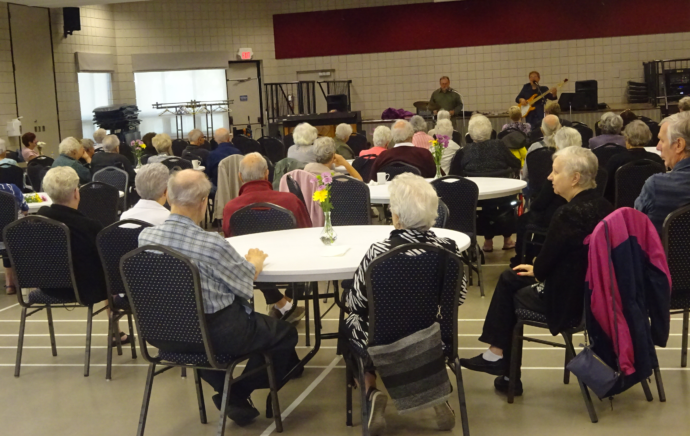 Music programs are part of the program offering at the Seniors’ Centre The city hires and pays the centre’s program instructors and determines the content. All seniors’ centre membership fees his group received as BSCI were forwarded to and managed by the city, he said. However, BSCI did receive and manage money donated directly to it by independent groups like The Boutique Ladies, which sold handmade items and donated proceeds to BSCI, and Club Nine. “All of those generous donations were given to BSCI to be used at the discretion of BSCI’s board of directors. The board of directors chose, instead of using such donations for operating expenses, to add all of them to profits from running the bistro, day trips and events,” said Hendriks. He said the BSCI used these funds to purchase items that would benefit the members of the Burlington Seniors’ Centre, things like playing card tables, dirty dish carts, a fridge, freezer and utensils. As well, the BSCI had given tokens of appreciation to the centre’s volunteers such as free coffee, food vouchers for the bistro or Tim Horton’s cards. Hendriks wouldn’t say how much money is in the fund managed by BSCI/BSC, just that those funds “will continue to be used to further the interests of seniors in Burlington”. “No decisions will be made about those funds without thoughtful deliberation, transparency and input from the local seniors’ community.” 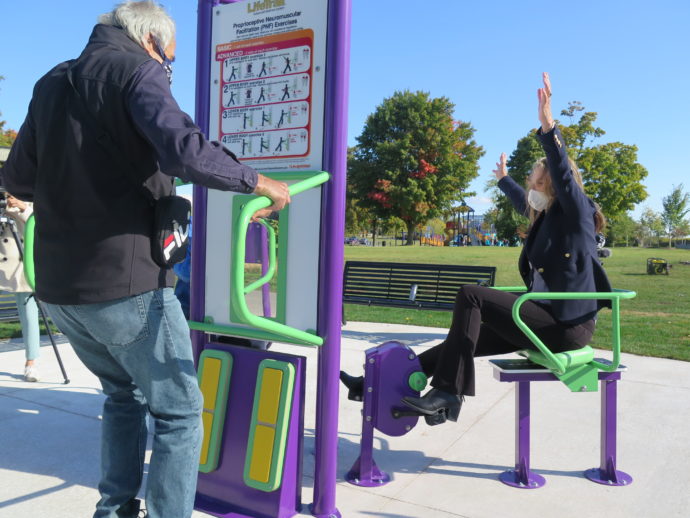 Mayor Meed Ward on the right and Regional Chair Gary Carr on the left at the unveiling of the exercise equipment at Burloak Park. Fast forward five years and we have the Mayor, the Regional Chair, a couple of members of council unveiling a plaque that says the equipment in the Burloak Park was purchased by the Burlington Seniors Centre, a not for profit private group that once used to run programs at the Centre and operated a very profitable Bistro. When the city parted ways with the group they took the money they had (it was a substantial amount) and used it for events that benefited the senior community. The exercise equipment was their most recent initiative. Finding a place to put the equipment turned out to be a real challenge. The city provided little in the way of help. They were eventually able to find a space in the Burloak Park. The preferred site was somewhere in Central Park. The working relationship between Parks and Recreation and the seniors group was never healthy. When things were difficult back in 2013 the seniors decided their issues would get attention if they went after members of Council – that tactic worked. 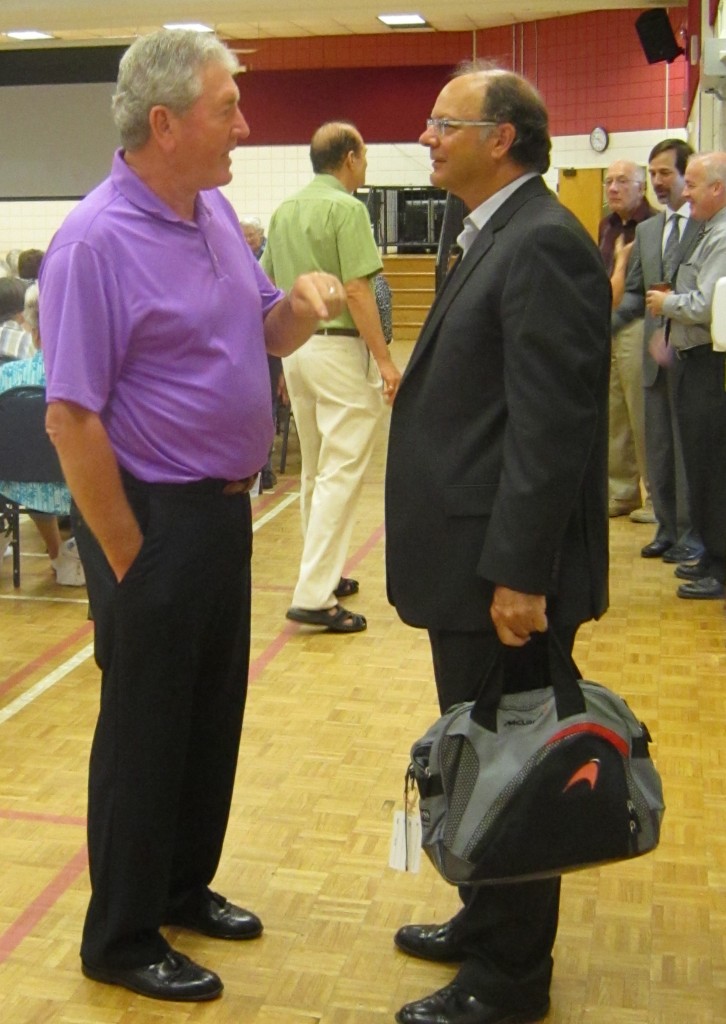 City manager Jeff Fielding with Joe Lamb, negotiating for the Seniors’ Centre Jeff Fielding was the city manager at the time; he was a delight to work with as far as the seniors were concerned. The problems were worked out. When James Ridge became city manager a lot of things changed. The Seniors’ Centre is administered by the Parks and Recreation department which many feel has never really understood what the seniors want and need in terms of recreation and exercise needs. The Gazette recalls an occasion when ward 2 Councillor Marianne Meed Ward took part in a “listening” exercise. She met with anyone who wanted to take part in a gathering of people at the Centre to talk about the issues. It was a somewhat muted occasion when members found that staff were lined up at the back of the room listening carefully. Members felt intimidated and not prepared to speak out. Parks and Recreation has not been able to find people who can empathize with the seniors, understand their concerns and put up with some of their limitations. This isn’t the story that got told out at Burloak Park Thursday morning. 
October 1st, 2020 BURLINGTON, ON
When we read about infection reports that are above 500 across the province and read about the severe restrictions being imposed in Quebec – it is reasonable to ask – What do I have to do to be safe? We were invited out for Thanksgiving and wrote our friends asking if we could at least think about re-scheduling. We have our own bubble that we are careful to maintain. It’s just the two of us and a couple of dogs. The vet was over yesterday – I was surprised about how casual he was – no mask either. With people returning to their offices and rising up an elevator with five or six people that they don’t know – not something I want to have to do. 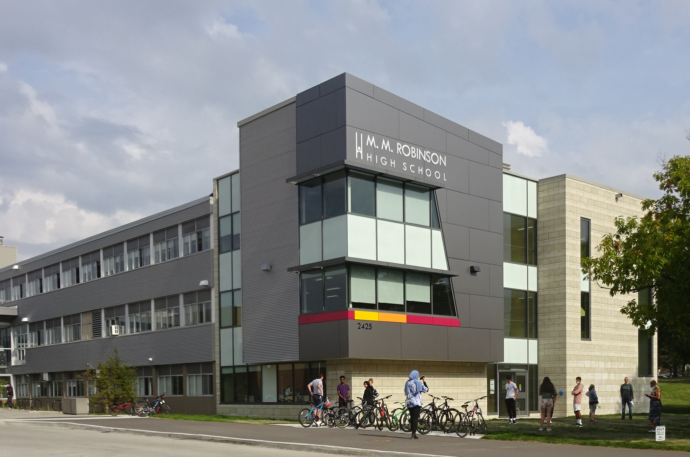 M M Robinson High School has not reported any infections. We are getting reports from schools – there are infections. Nothing serious – not glaring hot spots – yet. Is this because we are all very careful or just lucky? Ten schools have reported infections, all are secondary schools. None of the schools have been closed and the number reported that could be infected is at the 1 and 2 level. 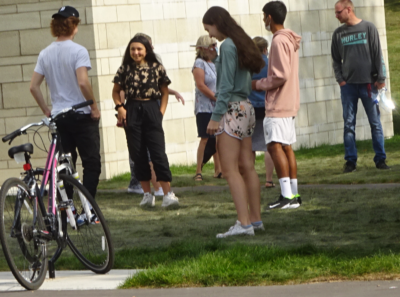 Students milling around outside the high school between classes keep a safe distance without supervision. The province has released a revised approach to screening students before they head for school every day. Like most government documents it is too long. The list of things to watch for is good and is set out below. Claire Proteau has a very open respectful relationship with her students. She reports that about 20% of her school population opted for virtual classes. One of the biggest issues for Proteau is the level of education her staff is able to deliver with all the COVID precautions in place. She works closely with the department heads and ensures that they are in very close touch with the classroom teachers. “But it isn’t the same” she said. “It is very hard to deliver a quality education under these circumstances.” Proteau isn’t complaining, she just does her best to ensure that her students are getting the help they need to cope with what everyone has to deal with and at the same time strive to give them the education they deserve. “I have a great bunch of students, they are a delight to work with and my teachers are giving it everything they have. If there are problems we will deal with them.” If we exercise that abundance of caution we will get through this. When we learn of the hundreds that are found to be infected each day we know that some people don’t take the precautions. They are usually the ones that move their lips when they read.

October 1st, 2020 BURLINGTON, ON
It was an eleven hour meeting that went as smoothly as things like this can go. The result – the city now has an Official Plan that it will soon send to the Regional government where it has to be approved.  They were sworn in to deliver – yesterday – they delivered. Getting the document to this point has been a massive effort on the part of the people in the Planning Department where many of the people in place now are new to the city. 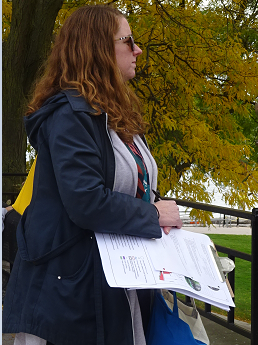 Alison Enns on a walking tour with a group of citizens. Alison Enns and Thomas Douglas did a huge job of involving the public and fattened their resumes with some superb work. Director of Planning Heather MacDonald, new to the city as well, was able to get staff to meet the call every time she asked. Council deserves credit – they believed a better Official Plan was necessary and they hung together for the most part to see it to the point where it passed through the Standing Committee on a 6-1 vote with Councillor Sharman being the exception. 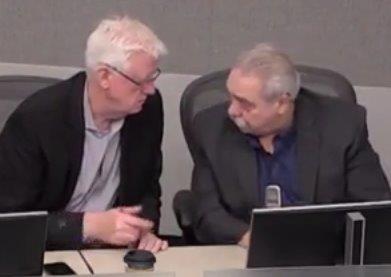 Councillor Sharman with Councillor Bentivegna – they voted against the 9 Meed Ward amendments – with one exception. His decision not to support the motion was as much a political move as a vote against what is a good Official Plan. This Council did the work that the 2014-18 Council wasn’t able to get done. Even Councillor Sharman admitted as much. Mayor Meed Ward did what she always does – did it her way. She, along with ward 2 Councillor introduced nine amendments to what the Planning department brought forward.  Mayor Marianne Meed Ward – she ran on creating a better Official Plan – she has delivered. Much of the amendments focus was on the eastern side of the city where Meed Ward brought forward reasonable changes. Most people agreed with the Mayor; although the Lions Club would have liked the Mayor to look upon the block sized property they own a little differently. The specifics of the nine amendments will get covered in future Gazette articles. The now endorsed Official Plan gets put before a City Council meeting early in October where it will be passed. Is it the right plan for the city? Only time will tell – what is not in doubt is the size of the effort from everyone involved. The plan should get through the Regional level – but it looks as if a number of vested interests are going to appeal the document. The number of letters put on the record by different developers and the legal counsel that have in the past represented the interests of the developers more than suggests the battle isn’t over. 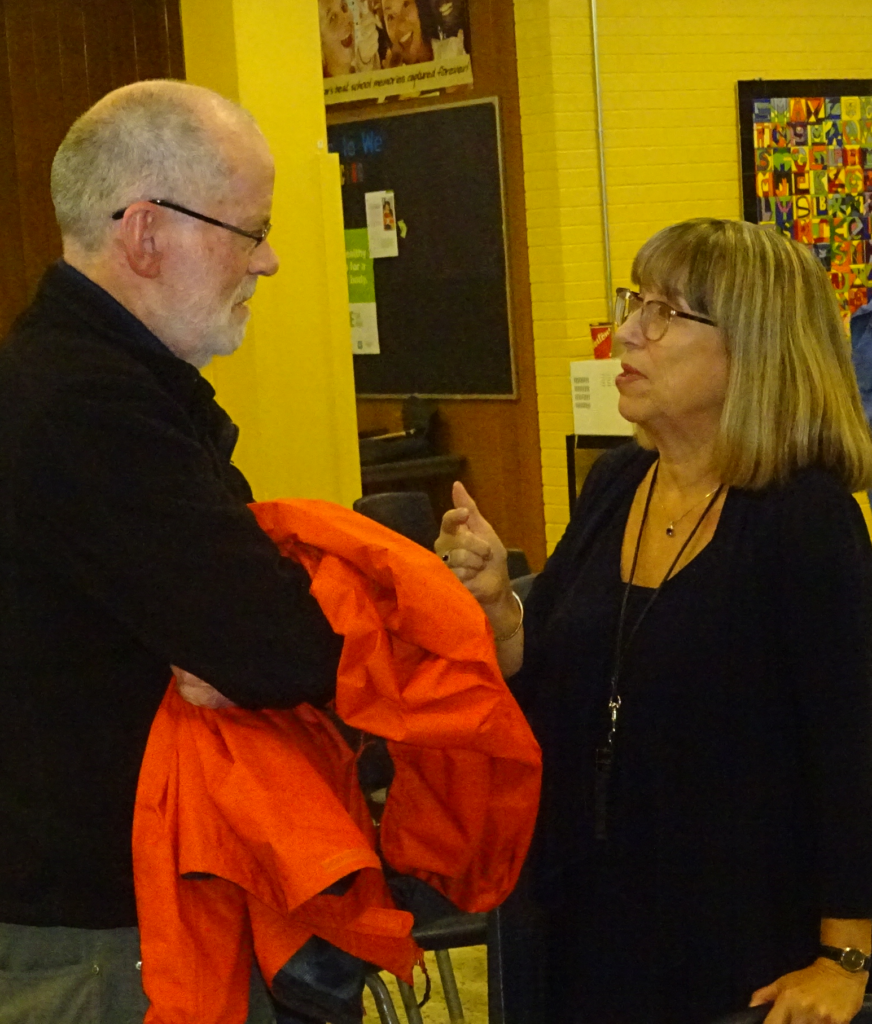 Heather MacDonald talking with a citizen at a public meeting – we used to have events like this. Is the plan defensible at LPAT is the question on many minds. Only time will tell. Heather MacDonald was given the task of hiring consultants to support the work that had to be done. The firm hired –SGL Planning & Design Inc., was her choice – she chose well. 
September 30th, 2020 BURLINGTON, ON
City Council is meeting today as a Standing Committee that is preparing to endorse the recommendation from the Planning department on a Scoped Review of the downtown portion of an Official Plan that was approved in xx 2018, went to the Region for approval – the Region returned the Official Plan pointing to four areas that did not comply with the Regional Official Plan. In sending the plan back to be made conforming with the Region the invited the city to make additional changes. That allowed the current city council to make all the changes they thought the city needed. That process, which began in 2018 is coming to a head today. 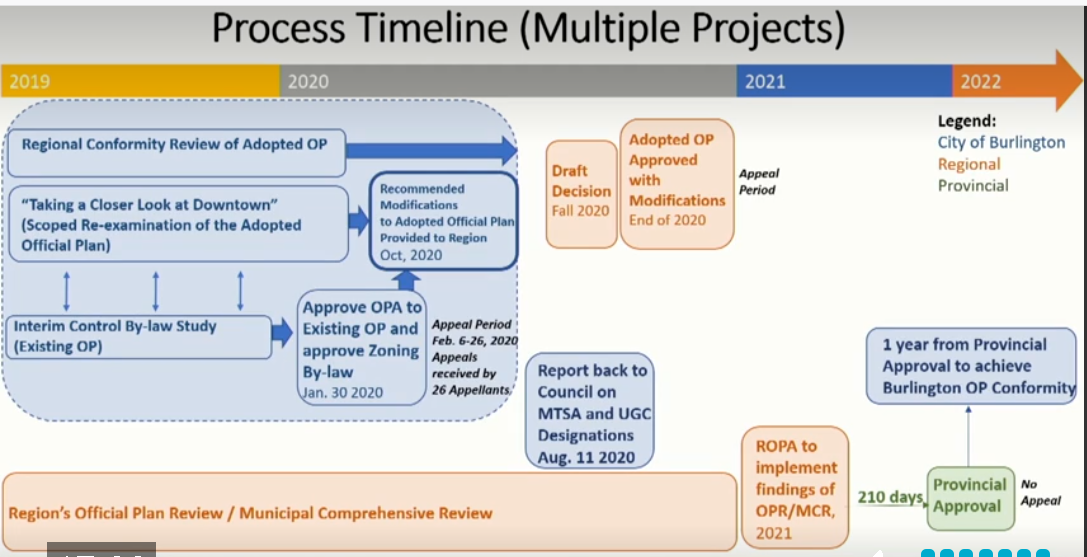 A complex process that is coming to a head at council today. The consult the city hired is doing a superb job; planning staff have set new heights in terms of the community outreach they have done. Some of it has been excellent – what has not been all that excellent is the public participation. There were walking tours that had less than 20 people. The Action Labs were an interesting approach. The city has gone through two Planning directors – the difference between the two has been very evident. Councillors are facing a full day’s work. The delegations and letters sent to council went from a through to r. A lot of people want to be on the record for this run at getting an Official Plan in place that can change the way the city will grow as it faces significant population growth targets. The Gazette will report in detail on what was said and who said it. 
September 29th, 2020 BURLINGTON, ON
The city now requires developers to take their plans to the public and get feedback at that level before taking their project to the Planning Department. The ADI Development Group will be telling their story to the public on Tuesday, September 29, 2020 Time: 5:30 -7:00 PM. Participate On-Line via Zoom: https://zoom.us/j/91873809076 Webinar ID: 91873809076 During the meeting, City Planning staff will provide an overview of the development application review process and opportunities for public participation in the process. Adi Development Group will provide an overview of their redevelopment plans. This proposed development consists of two different design options for community feedback. The first of which consists of three towers with heights ranging from 29 to 39 storeys, and the second option consists of four towers with heights ranging from 18 to 39 storeys. Both options yield the same approximate number of units, 1,258. There will be a question and answer session to share your thoughts about the proposal with Adi Development Group. Councillor Kelvin Galbraith and the Mayor will also be in attendance to hear your input. The four towers are the second phase of this development known as Station West which is within walking distance of the Aldershot GO station.

September 28th, 2020 BURLINGTON, ON Our apologies for the delay in getting this transit information to you. The city sent it out during the day rather than a few days before hand. Detour for Transit Route 4 – Sept. 29 to Oct. 1 Detour Area: Rexway Dr. Detour Dates: Sept. 29 to Oct. 1, 2020 Detoured Routes:
Stops not in service: 
September 28th, 2020 BURLINGTON, ON
The Halton Regional Police Service (HRPS) Drug and Human Trafficking Unit has recently concluded a year-long investigation titled, ‘Project Mover’. Beginning in Halton in late 2019, Project Mover spanned the Greater Toronto Area, and resulted in the largest fentanyl seizure in HRPS history, with a value of more than $4 million. Nine individuals are facing a total of 30 charges in relation to this investigation.
Project Mover resulted in the seizure of the following: • 10.25 kilograms of fentanyl The following individuals have been arrested and charged: Jorge Zamora (28) of British Columbia Ian Singh (31) of Markham Karen Tran (28) of Toronto Joseph Piansay (26) of Brampton Domenic Mamone (47) of Hamilton Jordan Treleaven (28) of Oakville Douglas Johnson (46) of Oakville Jani Suutarinen (44) of Alberta Craig Grant (21) of Mississauga
Tips can also be submitted anonymously to Crime Stoppers. “See Something? Hear Something? Know Something? Contact Crime Stoppers” at 1-800-222-8477 (TIPS) or through the web at www.haltoncrimestoppers.ca. 
September 28th, 2020 BURLINGTON, ON
Do you need to test for the Covid 19 infection? If you needed one – were you able to get a test? Where would you go to be tested? When would the results be available to you? More questions and answers. And a very mixed message from the provincial government. The province put out a graphic that should help.

September 28th, 2020 BURLINGTON, ON
The intersection of Brant and Ghent is a bit of a waste land. An empty field on the west side north of Ghent, a parking lot on the east side north of Ghent. A low two story office building that has seen better days is on the south side Ghent on the corner of Brant. You could drive by and not know what you had just passed. That location is in the process of changing. The Molinaro Group released architectural renderings and announced a date for the now required pre-consultation meetings with the public before an application can be taken to the Planning department. This is a development that isn’t within what most people see as the “downtown core” – which suggests that it will pass muster with the people that are fighting for what they call the heart and soul of the city Given the virtual world we live in everything is now accessible by a Zoom link. To participate On-Line via Zoom go to the web site set out below and use the webinar ID set out below. https://zoom.us/j/96657726680 Burlington is in the process of beginning to look like a very different city. 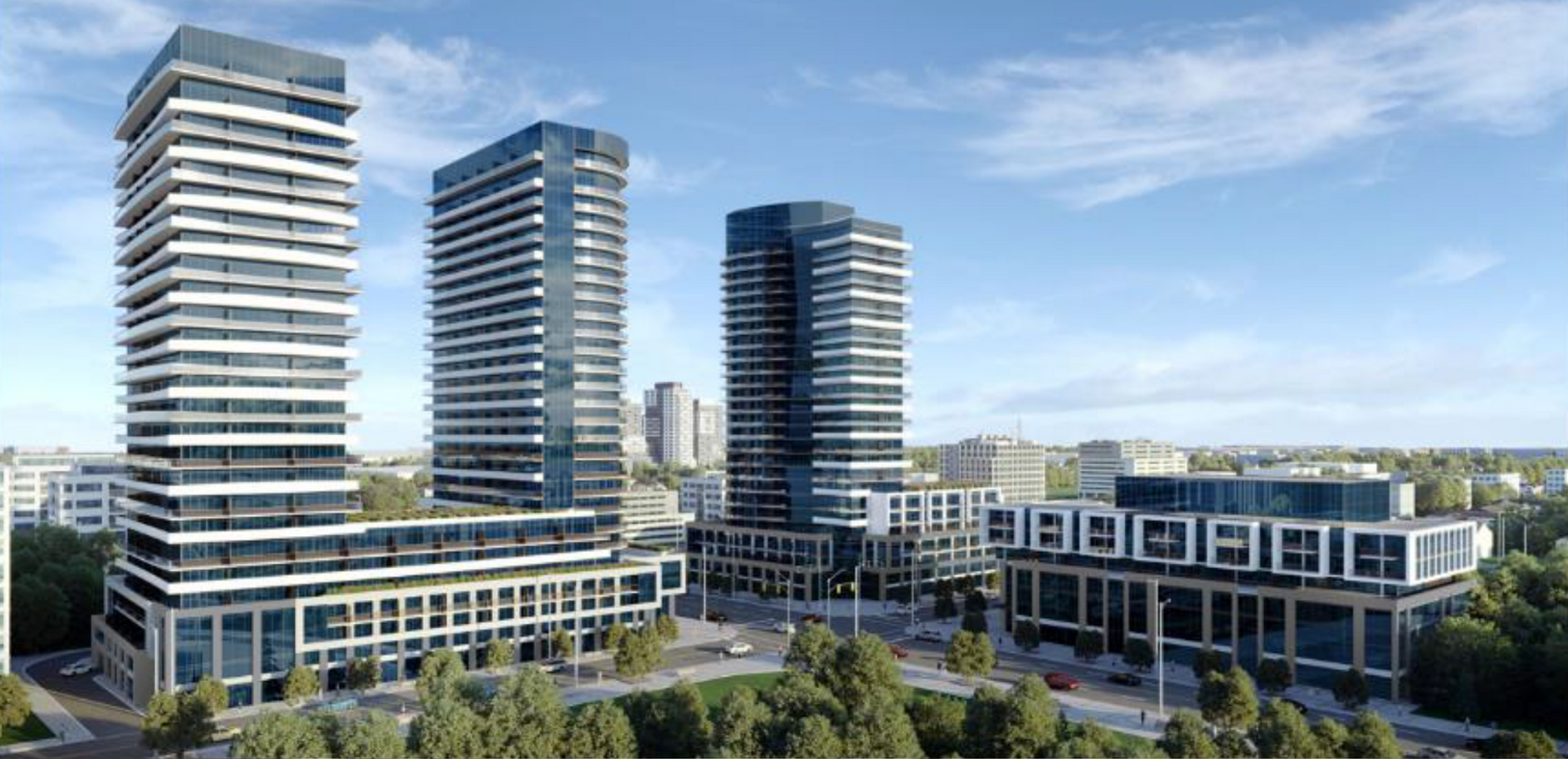 Three 25 story buildings with some townhouses on Brant thrown in. 
September 28th, 2020 BURLINGTON, ON
Everyone with ears will have heard that there were 700 new COVID infections across the province. And many will have heard that we are into a second wave of infections (no kidding) and that it should peak at around 1000 new infections a day by the middle of October. Ontario Premier Doug Ford called the province’s record-setting new case count Monday for COVID-19 “deeply concerning” but announced no new public health measures, despite calls by a group of doctors and medical experts calling for a return to Stage 2. The province reported an additional 700 cases of the infection on Monday, the most on a single day since the outbreak began in late January.  The picture appears to be that of a beleaguered man – – time for the Premier to begin walking the tough talk. Speaking to reporters, Ford said Ontario is indeed embarking on its second wave, which will be “more complicated, more complex — it’ll be worse” than the first. Still, asked about calls by the Ontario Hospital Association (OHA) to re-implement restrictions to limit the spread of the novel coronavirus, Minister of Health Christine Elliott said, “We don’t want to turn back a stage unless we absolutely have to.”  Is there a covid rule that isn’t broken in this picture? The province also announced the recruitment of 3,700 more health-care workers and caregivers, including nurses and personal support workers (PSWs), at a price tag of $52 million. Burlington has for the most part been sparred really significant new infections. The breakdown of that 700 number had Halton with more new infections than Hamilton. Niagara Region: 20 Nelson High School reported 2 infections. 
September 28th, 2020 BURLINGTON, ON OPINION Last June Regan Russell was walking in front of a transport truck that was loaded with hogs that were being taken into the Fearmans slaughter house. The truck had stopped until protesters finished walking front of it; Regan Russell wasn’t able to get out of the way in time and was run over by the truck. She died at the scene. 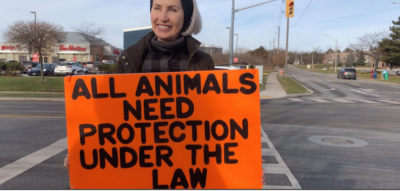 Regan Russell The slaughter house is part of a group of slaughter houses across the country that are owned by Sofina Foods. Regan was one of a number of demonstrators who gather regularly at the Harvester Road/Appleby Line intersection to, as they put it, “bear witness to what is taking place” and to attempt to water the hogs. They see what they are doing as a peaceful demonstration. They are indeed slowing down the entry of the truck into the meat processing plant. Regan was run over by the truck that apparently didn’t see her. She was slight in stature and the front of the truck was very high. The Regional Police investigated and came to the conclusion that a 28-year-old male from the Municipality of North Perth was to be charged with Careless Driving Causing Death under the Highway Traffic Act. The police reported that ‘there were no grounds to indicate this was an intentional act, or that a criminal offence had been committed.” 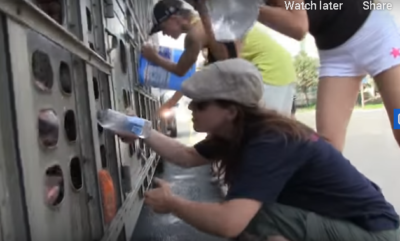 The protesters usually arrive as a group waiting for the transport truck to enter the slaughterhouse. Animal Rights protesters have been demonstrating at that location for a number of years. The meat processing plant, in operation since the 1960’s, has no intention of moving and currently employs 1000 people. The provincial government recently passed legislation that would give the municipalities that have demonstrator problems “tools” to handle these situations. The argument is that the issue is really one of public safety – they want the demonstrators out of the way. Strong legislation certainly helps do that.  Protestors water hogs when the transport has to stop for a traffic light at the entrance to the slaughterhouse. At the Monday City Council meeting a resolution was put forward and passed unanimously. The Resolution reads: Whereas the Security from Trespass and Protecting Food Safety Act, 2020 recognizes the unique risks that can result from interfering with livestock transport including creating unsafe work conditions as well as causing stress to animals and introducing diseases or contaminating our food supply; and Whereas Sections 6(1), 7, 14(1) 3 and 15(1) of the Act came into effect on September 2, 2020 and prohibit the stopping, hindering, obstructing or otherwise interfering with a motor vehicle transporting farm animals; and Whereas protest groups, including minor children, present outside the Sofina pork plant in Burlington continue to reach inside livestock trailers to touch, film and give water to the pigs creating an unsafe situation where they may be injured by the animals or trailer; and Whereas the recent tragic loss of the life of a protester in Burlington underscores the urgent need to ensure the safety of all involved; and Whereas Section 6(2) of the Act states that no person shall interfere or interact with a farm animal being transported by a motor vehicle without the prior consent of the driver of the motor vehicle; Therefore be it resolved that the City of Burlington pass a resolution urging the Ontario Minister of Agriculture, Food and Rural Affairs to immediately proclaim Section 6(2) of the Act in order to provide a legal basis to prevent the unsafe practice of protestors having contact with livestock trailers and animals; and That this resolution be forwarded to Ontario Minister of Agriculture, Food and Rural Affairs, the Association of Municipalities of Ontario and the Region of Halton. Those in favour of the motion didn’t have a word to say about the right of people to protest.  Hog suffering from heat while being transported. Councillor Sharman sounded more like a shill for Sofina Foods (they are in his ward) rather than a person responsible for the wider community. The puffball questions he asked the three delegations were embarrassing. Which begs the question: Why not find a way to allow the Animal Rights people to demonstrate, maybe even water the hogs while the trucks wait at the gate for 10 minutes. After which the demonstrators would be required to move on. The Conservation Authority closes off a portion of Kind Road for weeks in the spring so that the Jefferson Salamander can cross the road and mate in the wetlands.  He isn’t exactly pretty but nevertheless plays an important role in the local environment. In 2008 a provincial tribunal found that the loss of a habitat for the Jefferson Salamander in north Burlington was reason enough not to give the Nelson Aggregate an extension to their license. We have a proud history of protecting endangered species. Admittedly hogs are not endangered but the right of people to voice their views in a public place is as important as making huge allowances for an endangered species. That history was sullied this morning by city council. Related news story: Protester run over by truck transporting pigs to slaughter. Salt with Pepper is the musings, reflections and opinions of the publisher of the Burlington Gazette, an online newspaper that was formed in 2010 and is a member of the National Newsmedia Council. 
September 26th, 2020 BURLINGTON, ON
You don’t get to see this very often Click on the link – when you get to the image on the screen click on the middle of the image. Then click on the video and hold your hand over your heart.

|
||||||||
|
Copyright © 2024 Burlington Gazette – Local News, Politics, Community - All Rights Reserved Powered by WordPress & Atahualpa |
||||||||